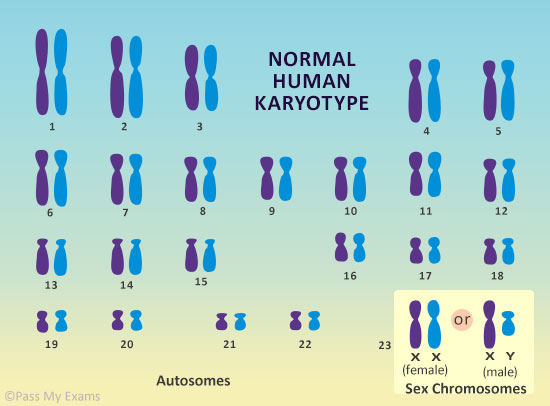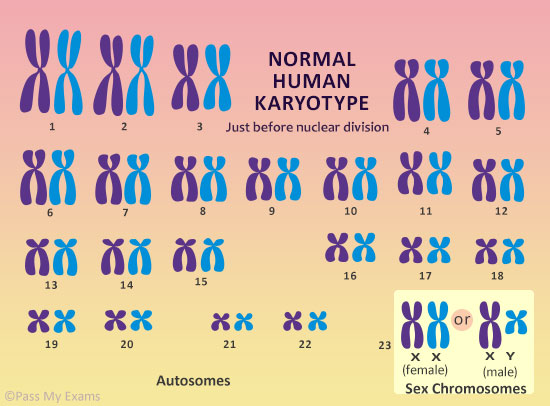What are chromosomes?
Chromosomes are string-like structures located inside the nucleus of animal and plant cells. The word chromosome is derived from the Greek words “chromo” meaning colour and “soma” meaning body. Scientists gave this name to chromosomes because the structures become strongly stained when colourful dyes are applied to them.
Chromosomes occur in pairs, and there are a different number of pairs of chromosomes in different species of animals and plants. Humans have 23 pairs, elephants have 28 pairs, cats have 19 pairs and a carrot plant has 9 pairs of choromosomes.
Structure of chromosomes
The long string like structure that makes up a chromosome is made up of a chemical called deoxyribonucleic acid (DNA). Each chromosome contains one DNA molecule. The DNA is coiled tightly around proteins called histones. These proteins provide structural support to a chromosome and allow the very long DNA molecule to form a compact shape and fit inside the nucleus of a cell. Individual chromosomes cannot be seen very clearly in the periods between cell division. This is because during this phase i.e. the interphase the chromosomes exist as very loosely coiled, long, thin threads spread throughout the nucleus. Before the nucleus of a cell divides an exact copy of the DNA molecule in a chromosome is made so that at nuclear division the chromosome is a double structure, containing two identical DNA molecules. These two part structure of chromosomes are called chromatids with each chromatid of the pair containing one of the two identical DNA molecules. Just before nuclear division takes place the chromosomes coil up into shorter, thicker more compact structures and the chromatids become recognisable as separate structures. It is these structures that are much more visible under a microscope and therefore more commonly used when showing chromosomes.
The image below shows the structure of a chromosome just before nuclear division made up of two chromatids. The chromatids are held together at a point called the centromere. The centromere may occur anywhere along the length of the chromosome.

When the sets of chromosomes from a human are lined up according to size it can be seen that they exist in pairs. These are called homologous pairs because they are similar in structure. An image of such an arrangement of chromosomes is called a karyogram and the set of chromosomes is called the karyotype. In humans there are 23 pairs of chromosomes. The reason the chromosomes are in pairs is because one set of chromosomes comes from the female parent via the egg and the other set of chromosomes comes from the male parent by way of the sperm. During fertilisation when the sperm cell fuses with the egg cell the resulting cell is called a zygote and contains two sets of chromosomes.
The diagram below shows a representation of the karyogram for humans. It shows the homologous sets as chromosomes.

The diagram below shows the homologous chromosome pairs as chromatids just before nuclear division. It is the representation as chromatids which is the more recognisable structure normally used.

Function of chromosomes
For all living organisms to grow and function properly all cells must divide to produce new cells. During cell division it is important that the DNA molecule is evenly distributed among the cell. The chromosomes play a key role in this process as they ensure the DNA is accurately copied and distributed.

